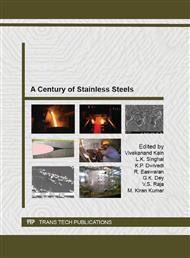p.552
p.564
p.575
p.583
p.592
p.598
p.606
p.618
p.626
Influence of pH on Hydrogen Absorption in Duplex Stainless Steel
Abstract:
With rising demands, oil and gas exploration of high-pressure high-temperature (HPHT) wells are increasing worldwide. Due to aggressiveness of HPHT environments, piping and equipments are constructed with high-strength corrosion resistant alloys (CRAs). Duplex stainless steel is one of the candidate alloys that offer high strength along with corrosion resistance. It possesses the advantages of both austenitic and ferritic stainless steels and hence, the name duplex or dual phase stainless steel. In order to control corrosion, cathodic protection is commonly being employed on the structures and equipment. Cathodic protection is accomplished by applying a direct current to the structure which causes the structure potential to change from the natural corrosion potential (Ecorr). The required cathodic protection current is supplied by sacrificial anode materials or by an impressed current system. Hydrogen embrittlement (HE) is an associated phenomenon, which results in the production of hydrogen ions, leading to its absorption in the protected metal and subsequent hydrogen embrittlement of metals and welds. To prevent this embrittlement, cathodic protection is closely studied in terms of finding the critical potential, pH, temperature etc. that does not cause hydrogen embrittlement. This paper describes the study carried out to find the role of pH on the absorption of hydrogen in Duplex Stainless steel. It has been observed that at a critical pH, hydrogen intake in the sample is very high, as compared to the pH below and above the critical pH. Critical pH observed for duplex stainless steel is a trade of between hydrogen evolution and absorption for given duplex structure.
Info:
Periodical:
Pages:
592-597
Citation:
Online since:
September 2013
Authors:
Keywords:
Price:
Сopyright:
© 2013 Trans Tech Publications Ltd. All Rights Reserved
Share:
Citation:


